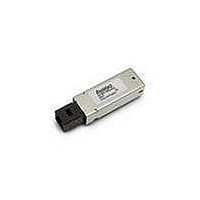AFBR-5921ALZ Avago Technologies US Inc., AFBR-5921ALZ Datasheet - Page 3

AFBR-5921ALZ
Manufacturer Part Number
AFBR-5921ALZ
Description
TXRX SSF 3.3V 2/1GBS PTH 2X5
Manufacturer
Avago Technologies US Inc.
Series
-r
Datasheet
1.AFBR-5921ALZ.pdf
(13 pages)
Specifications of AFBR-5921ALZ
Data Rate
2.125Gbps
Wavelength
850nm
Applications
General Purpose
Voltage - Supply
2.97 V ~ 3.63 V
Connector Type
LC Duplex
Mounting Type
Through Hole
Function
SFF, PTH, Low Voltage 3.3 V, Optical Transceiver for Fibre Channel
Product
Transceiver
Maximum Rise Time
0.15 ns/0.2 ns
Maximum Fall Time
0.15 ns/0.2 ns
Pulse Width Distortion
0.063 ns (Max)/0.076 ns (Max)
Operating Supply Voltage
2.97 V to 3.63 V
Maximum Operating Temperature
+ 85 C
Minimum Operating Temperature
- 10 C
Package / Case
DIP With Connector
Lead Free Status / RoHS Status
Lead free / RoHS Compliant
For Use With
Multimode Glass
Lead Free Status / RoHS Status
Lead free / RoHS Compliant, Lead free / RoHS Compliant
Available stocks
Company
Part Number
Manufacturer
Quantity
Price
Company:
Part Number:
AFBR-5921ALZ
Manufacturer:
Avago Technologies
Quantity:
135
Recommended Cleaning/Degreasing Chemicals
Alcohols: methyl, isopropyl, isobutyl.
Aliphatics: hexane, heptane.
Other : naphtha.
Do not use partially halogenated hydrocarbons such as
1,1.1 trichoroethane or ketones such as MEK, acetone,
chloroform, ethyl acetate, methylene dichloride, phenol,
methylene chloride, or N-methylpyrolldone. Also, Avago
Technologies does not recommend the use of cleaners
that use halogenated hydrocarbons because of their
potential environmental harm.
Transmitter Section
The transmitter section includes an 850 nm VCSEL (Vertical
Cavity Surface Emitting Laser) light source and a transmit-
ter driver circuit. The driver circuit maintains a constant
optical power level provided that the data pattern is valid
8B/10B code. Connection to the transmitter is provided
via an LC optical connector.
TX Disable
The AFBR-5921ALZ accepts a transmit disable control
signal input which shuts down the transmitter. A high
signal implements this function while a low signal allows
normal laser operation. In the event of a fault (e.g., eye
safety circuit activated), cycling this control signal resets
the module. The TX Disable control should be actuated
upon initialization of the module. See Figure 5 for product
timing diagrams.
Eye Safety Circuit
For an optical transmitter device to be eye-safe in the
event of a single fault failure, the transmitter will either
maintain normal, eye-safe operation or be disabled. In the
event of an eye safety fault, the VCSEL will be disabled.
Receiver Section
Connection to the receiver is provided via an LC optical
connector. The receiver circuit includes a Signal Detect (SD)
circuit which provides an open collector logic low output
in the absence of a usable input optical signal level.
Signal Detect
The Signal Detect (SD) output indicates if the optical
input signal to the receiver does not meet the minimum
detectable level for Fibre Channel compliant signals.
When SD is low it indicates loss of signal. When SD is high
it indicates normal operation. The Signal Detect thresh-
olds are set to indicate a definite optical fault has occurred
(e.g., disconnected or broken fiber connection to receiver,
failed transmitter).
3
Functional Data I/O
Avago Technologies’ AFBR-5921ALZ fiber-optic transceiver
is designed to accept industry standard differential signals.
In order to reduce the number of passive components
required on the customer’s board, Avago Technologies has
included the functionality of the transmitter bias resistors
and coupling capacitors within the fiber optic module.
The transceiver is compatible with an “AC-coupled” con-
figuration and is internally terminated. Figure 1 depicts
the functional diagram of the AFBR-5921ALZ.
Caution should be taken to account for the proper inter-
connection between the supporting Physical Layer inte-
grated circuits and the AFBR-5921ALZ. Figure 3 illustrates
the recommended interface circuit.
Reference Designs
Figure 3 depicts a typical application configuration, while
Figure 4 depicts the multisourced power supply filter
circuit design.
Regulatory Compliance
See Table 1 for transceiver Regulatory Compliance perfor-
mance. The overall equipment design will determine the
certification level. The transceiver performance is offered
as a figure of merit to assist the designer.
Electrostatic Discharge (ESD)
There are two conditions in which immunity to ESD
damage is important. Table 1 documents our immunity
to both of these conditions. The first condition is during
handling of the transceiver prior to attachment to the PCB.
To protect the transceiver, it is important to use normal
ESD handling precautions. These precautions include
using grounded wrist straps, work benches, and floor mats
in ESD controlled areas. The ESD sensitivity of the AFBR-
5921ALZ is compatible with typical industry production
environments. The second condition is static discharges
to the exterior of the host equipment chassis after instal-
lation. To the extent that the duplex LC optical interface
is exposed to the outside of the host equipment chassis,
it may be subject to system-level ESD requirements. The
ESD performance of the AFBR-5921ALZ exceeds typical
industry standards.
Immunity
Equipment hosting the AFBR-5921ALZ modules will be
subjected to radio-frequency electromagnetic fields in
some environments. The transceivers have good immunity
to such fields due to their shielded design.

























